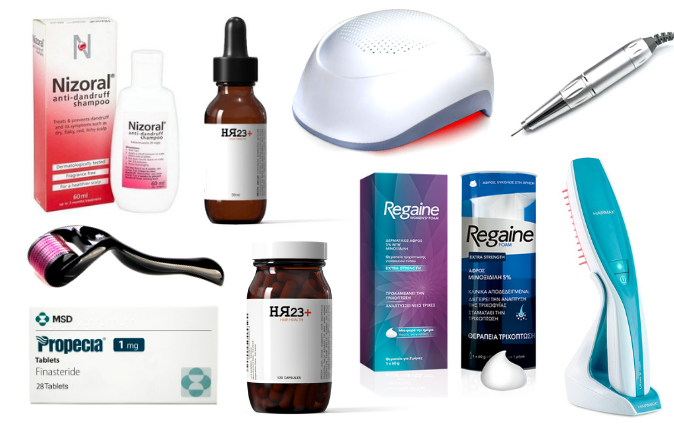
Tackling female hair loss
Hair loss affects over 50 percent of women by the age of 40, and that figure goes up to around 65% by the age of 50. When you think about it, that statistic is quite remarkable, especially when you consider that hair loss is more commonly associated with men.
There are many causes and types of hair loss, including a handful that are more specific to women. Some hair loss types are temporary, but other types are longer lasting, and therefore much harder to treat.
It is normal to lose between 50-150 hairs a day, because we are constantly generating new hair growth, however, thinning will occur when the scalp stops generating new hair growth.
A hair growth cycle consists of three phases; the Anagen phase, the catagen phase, and the telogen phase. The anagen phase can last for many years, but during the catagen phase, the hair stops growing and separates from its follicle, and lasts about 10 days. During the telogen phase, the follicle rests for two to three months, before the hair falls out. The next anagen phase begins as a new hair grows in the same follicle.
There are more varying types of hair loss in women than there are in men. Some of the more common female hair loss types include postpartum hair loss, menopausal thinning, and seasonal shedding.
Different types of hair loss can be treated varyingly, but here are a selection of treatments that can be effective for treating most hair loss types. What’s more, these treatments can be used in conjunction with one another, for optimal results.
Treatments for Hair Loss
There are quite a few options available for treating baldness and thinning hair. The market is saturated, and most products have no success in treating the hair, however, there are some good treatments on the market that can help slow down and even stop excessive hair shedding.
Medically Approved Treatments
There are only two medically approved treatments for hair loss. The first is finasteride, which is an oral pill for male pattern baldness. The second is minoxidil, which is a topical solution for men (5% solution) and women (2% solution).
Both treatments can give promising results, however, both can also cause negative side-effects, particularly finasteride. Men tend to suffer from more severe side-effects than women do. Both treatments have shown to be effective, to a minor extent, however, many men and women are not willing to compromise on their health, and therefore either use it sparingly, or seek safer alternatives.
Hair Surgery
Surgical procedures, such as hair transplants, offer women a viable solution for hair loss, but they tend to be expensive. Surgical treatments can range from £3000-£10,000+, depending on what needs to be done. It is more than likely that more than one surgical treatment will be needed, so it is an ongoing treatment.
Hair transplants tend to work better with men, for two reasons. Firstly, hairline restoration is easy to do, and well suited to hair transplantation. Hairline recession is a common symptom in men. And secondly, men tend to thin in certain areas – either at the frontal hairline, or at the crown. Women tend to thin more widespread, which makes hair transplantation more difficult to do, and less effective.
However, that’s not to say hair transplantation cannot be effective for women. It depends on the severity of the thinning, and the hair type. Some surgical procedures can be effective for women.
Hair Growth Supplements
Multi-vitamin hair growth supplements like HR23+ are safe alternatives to the harsh prescription drugs. Many women are experiencing excellent improvements in their hair from using multi-vitamin supplements, and they have now become the most popular choice of hair care product on the market.
Multi-vitamin supplements can help stop hair loss and thinning, support the function of healthy hair growth, and increase the thickness of the strands. These types of supplements are becoming the most popular treatment for hair loss.
Keratinocyte Growth Factor (KGF)
Keratinocyte growth factor (KGF) is an important endogenous mediator of hair follicle growth, development, and differentiation. When used regularly, KGF can help with the prevention of hair loss, and promotion of function of healthy hair growth, in both men and women.
The most common, and recommended form of KGF, is to use it as a serum. Applying KGF to the scalp, just 3-4 times a week, can help combat hair loss, with no major side-effects.
Micro Needling
Micro needling involves the use of a derma roller (or derma stamp) which contains small needles that causes minor skin injuries. While used as an anti-aging skin treatment, micro needling may also be a method of treatment for hair loss. There’s even evidence that it can help a special type of hair loss known as alopecia areata.
Derma devices have become increasingly popular among men and women who are battling hair loss. Some users are experiencing new hair regrowth from derma rolling/derma stamping just 1-2 times a week. Derma devices vary in needle sizes, usually from 0.5mm – 1.5mm.
Low Level Laser Therapy
You may have heard that laser combs, brushes, hoods, and caps can help stop hair loss and encourage hair growth, but more research and testing is needed to confirm exactly how effective this treatment is. The theory is that when hair follicles absorb laser light at a certain level, it stimulates hair to grow. Devices can range from £150-£1000, or alternatively you can get the treatment done at hair clinics.
Ketoconazole Shampoo (Nizoral)
Ketoconazole is an antifungal drug used to manage scalp conditions like dandruff. But ketoconazole is also used as a hair loss treatment for androgenetic alopecia (genetic pattern baldness) in both men and women. Although its not medically approved, Nizoral shampoo, which contains ketoconazole, has shown to help treat hair loss when used in conjunction with other treatments.
Ketoconazole shampoo has shown to be particularly effective for re-growing hair, when used in conjunction with micro-needling and minoxidil. Nizoral shampoo only needs to be used once a week.
What is the most Effective Hair Loss Treatment for Women?
It is difficult to define exactly what treatment is the most effective for hair loss in women, but one thing is for sure, a good hair care plan, with a variation of treatments, has shown to be more effective than just using a single product.
So, the most successful way to treat hair loss would be through multi-treatments. Treating hair loss is not easy, and cases will always vary from person to person, however, it’s not an impossible task, and many women are treating hair loss with some amount of success.
It will likely take a period of trial and error to establish what treatments work for you, and which ones work best in conjunction with each other. Once you have established this, along with your hair loss type, you’ll then be in a better position to treat hair loss, safely and effectively.



Leave a Reply